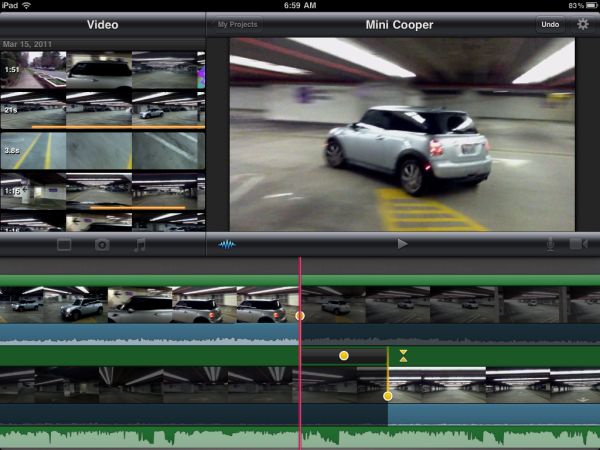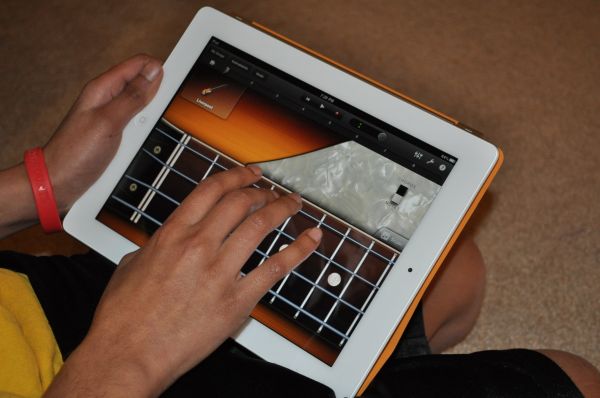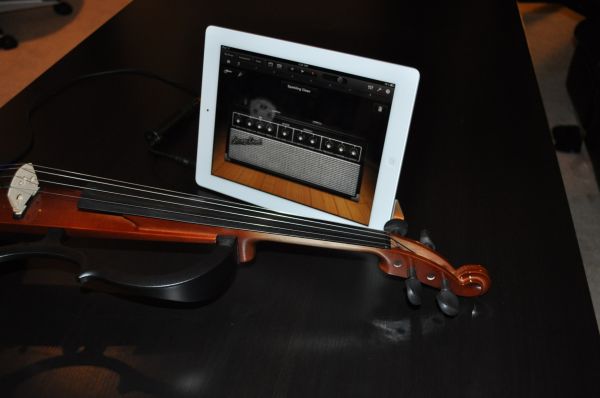The Apple iPad 2 Review
by Brian Klug, Anand Lal Shimpi & Vivek Gowri on March 19, 2011 8:01 PM ESTiMovie
by Vivek Gowri
Apple launched two new content-editing apps along with the iPad 2 - GarageBand and iMovie. iMovie is a $4.99 app available exclusively for iPad 2 (an updated iPhone 4/iPod touch 4 equivalent was launched simultaneously), so I'll start there.
iMovie basically lets you do a decent amount of video editing on the iPad itself. You can edit videos shot on the iPad, or video content imported from SD card using the camera connection kit. Unfortunately as we discovered in our testing, nearly all other sources of video aren't supported by iMovie. If you have grand visions of doing all of your video editing on the iPad 2 you'll want to hit the reset button on your expectations (or wait a few years until it's actually possible). Honestly, I can only see myself using it for video shot with the iPad, it makes the entire video editing process very streamlined on the device and makes video editing something you can do on the go. Just to test it out, I shot a series of videos of my car and stitched them together using iMovie, then added some titles and a soundtrack.
Being able to touch and swipe through the video clips and change the transitions and video cut points using a tactile input method actually makes it a lot easier to use than one would expect. Swipes and gestures rule the day, and it's a great way to edit various clips and put them together in a cohesive manner.
There's not a lot in the way of different options to deal with crossfades and transitions between clips, but the cross dissolve transition that is used as a default is pretty decent for amateur quality videos, especially since you can edit the length of the transition, and the various theme-specific transitions work too, if a little bit tacky.
But this is a video editing app for a 1.3lb tablet; considering that fact, you can get some pretty solid quality video out of it at the end. I'm pretty pleased with the video that I got out at the end, take a look for yourself.
You get a decent number of export options - Facebook, Youtube, Vimeo, CNN iReport (there's a CNN iMovie theme that can be added to videos as well), iTunes, and Camera Roll. From the camera roll, you can copy it to a computer and basically do whatever you want with it. iMovie isn't going to replace any serious video editing application, but I can see it being very useful during CES or another tradeshow - shooting video on the iPad, cutting it down, adding a few transitions, and uploading it in a matter of minutes, all from the same device.
Garage Band
by Vivek Gowri
GarageBand is a new app that Apple is releasing for both generations of iPad, for the same $4.99 price as iMovie, and beyond the basic premise of creating audio tracks from scratch, it's actually not that similar to the desktop app.
Apple has loaded a few instruments in GarageBand - a set of piano and keyboard options, a few drum kits, a vocal sampler/audio recorder from the mic, and even a virtual guitar amp, but the real story is the "Smart Instruments" that they have included.
Meet my brother, Gokul Gowri. He's 12, in 7th grade, and plays violin and piano at a relatively high level. I handed him my iPad 2 with GarageBand and asked him for his impressions.
After messing around with the included piano, he started experimenting with Smart Instruments. The first thing he said was that Smart Instruments could basically play the instrument for you, making good sounding audio clips and multilayered tracks easy to compose for even non-musically inclined people. There are four Smart Instruments - Piano, Bass, Guitar, and Drums. The Guitar is probably the most impressive one of the lot, with 6 strings and the ability to pick or strum at them. The cool part though, is that Smart Instruments will add the chords for you. They're preset chords and unfortunately, users can't define their own chords. That would let more advanced musicians really customise the guitar to their liking (my brother abandoned the smart chords really quickly after discovering he couldn't change them). The nice thing is that you can turn them off and pick your notes on the 6 strings individually. Smart Bass is exactly the same, except it's a four string bass instead of a guitar.
Smart Piano works similarly in that it takes away the actual keys and gives you a pad to press to get the note, with an option to sustain the notes. Smart Drums is another interesting one - you're provided with a grid dependant on volume and pattern complexity that you drag the various drum elements onto to generate a full rhythm.
And then of course, there's autoplay. Press the note, it'll play an entire clip for you, with the complexity of the clip depending on the level of autoplay selected. It's pretty cool if you're not a music person, but if you are, you can actually produce an interesting rhythm with the different options in Smart Instruments. There's a maximum of 8 tracks allowed, and you can duplicate and loop them to create a full song.
My brother decided to hold an impromptu recording session and ended up with this:
It sounds pretty good, especially considering that it was produced by a 12 year old on an iPad in 30 minutes. What my brother ended up doing is layering all four smart instruments to start, then adding in some included loops of orchestra strings to generate the second half of the clip. Pretty simple stuff, which is the goal behind GarageBand - allowing users to create complex sounds using simple musical constructs.
I personally was more curious about the virtual guitar amp. I'm a violinist who's been using an electric for the last couple of years, and I was curious to see if I could actually make use of the amp. I thought Apple would be using some form of line-in 3.5mm connector, but unfortunately, you have to get an external device to connect the electric guitar/violin. Apple recommends Apogee's Jam, though the AmpliTube iRig also works. I picked up an iRig ($39) to test out, since it's significantly cheaper than the $99 Apogee Jam, but the Jam is a studio quality device, so it's probably worth the extra money if you're really serious about it.
Unfortunately, the amp itself isn't all that great, for an electric violin at least. As a violinist, I have a different set of priorities than a guitarist - a clean sound is kind of the ultimate goal, even if a metal or some other after effect is applied. Most of the amp options in the virtual guitar amp don't give you very clear sound, so the violin ends up sounding pretty terrible. After listening to me play through the amp, my best friend took to calling my iPad the GarbageBand guitar amp. I think it'd be better for electric guitar players, since there isn't as much emphasis on clear sound, but it isn't going to replace a real amp by any stretch of the imagination.

















189 Comments
View All Comments
JarredWalton - Sunday, March 20, 2011 - link
Considering the source (ARMflix), you need to take that video with a huge grain of salt. It looks like they're running some Linux variant on the two systems (maybe Chromium?), and while the build may be the same, that doesn't mean it's optimized equally well for Atom vs. A9.Single-core Atom at 1.6GHz vs. dual-core A9 at 500MHz surfing the web is fine and all, but when we discuss Atom being faster than A9 we're talking about raw performance potential. A properly optimized web browser and OS experience with high-speed Internet should be good on just about any modern platform. Throw in some video playback as well, give us something more than a script of web pages in a browser, etc.
Now, none of this means ARM's A9 is bad, but to show that it's as fast as Atom when browsing some web pages is potentially meaningless. What we really need to know is what one platform can do well that the other can't handle properly. Where does A9 fall flat? Where does Atom stumble?
For me, right now, Atom sucks at anything video related. Sorry, but YouTube and Hulu are pretty important tools for me. That also means iOS has some concerns, as it doesn't support Flash at all, and there are enough places where Flash is still used that it creates issues. Luckily, I have plenty of other devices for accessing the web. In the end, I mostly play Angry Birds on my iPod Touch while I'm waiting for someone. :-)
Wilco1 - Sunday, March 20, 2011 - link
The article is indeed wrong to suggest that the A9 has only half the performance of an Atom. There are cases where a netbook with a single core Atom might be faster, for example if it runs at a much higher frequency, uses hyperthreading, and has a fast DDR3 memory system. However in terms of raw CPU performance the out-of-order A9 is significantly faster than the in-order Atom. Benchmark results such as CoreMark confirm this, a single core Atom cannot beat an A9 at the same frequency - even with hyperthreading. So it would be good to clarify that netbooks are faster because they use higher frequency CPUs and a faster memory system - as well as a larger battery...somata - Sunday, March 27, 2011 - link
CoreMark is nearly as meaningless as MIPS. Right now the best cross-platform benchmark we have is Geekbench. It uses portable, multi-threaded, native code to perform real tasks. My experience with Geekbench on the Mac/PC over the years indicates that Geekbench scores correlate pretty well to average application performance (determined by my personal suite of app benchmarks). Of course there will be outliers, but Geekbench does a pretty good job at representing typical code.Given that, the fact that a single-core 1.6GHz Atom (with HT) scores about 28% higher than the IPad's dual-core 1GHz A9s in the integer suite leaves me little doubt that the Atom, despite being in-order, has as good or better per-clock performance than the A9s.
Even the oft-maligned PowerPC G4 totally outclasses the dual A9s, with 43% better integer performance at 1.42GHz... and that's just with a single core competing against two!
tcool93 - Sunday, March 20, 2011 - link
Tablets do have their advantages despite what the article claims. For one thing, their battery life far out lives any Netbook or Notebook. They also run a lot cooler, unlike Notebooks and Netbooks, which you can fry an egg on. Maybe they aren't as portable as a phone, but who wants to look at the super tiny print on a phone.Tablets don't replace computers, and never will. There are nice to sit in bed with at night and browse the web or read books on, or play a simple game on. Anything that doesn't require a lot of typing.
Even a 10" tablet screen isn't real big to read text, but its MUCH easier to zoom in on text to read it with tablets. Unlike any Notebook/'Netbook, which its a huge pain to get to zoom in.
tcool93 - Sunday, March 20, 2011 - link
I do think the benchmarks shown here do show that there is quite an improvement over the Ipad 1, despite what many seem to claim that there isn't much of an upgrade.secretmanofagent - Sunday, March 20, 2011 - link
Anand,Appreciate the article, and appreciating that you're responding to the readers as well. All three of you said that it didn't integrate into your workflow, and I have a similar problem (which has prevented me from purchasing one). One thing I'm very curious about: What is your opinion on what would have been the Courier concept? Do you feel that is the direction that tablets should have taken, or do you think that Apple's refining as opposed to paradigming is the way to go?
VivekGowri - Sunday, March 20, 2011 - link
I still despise Microsoft for killing the Courier project. Honestly, I'd have loved to see the tablet market go that direction - a lot more focused on content creation instead of a very consumption-centric device like the iPad. A $4-500 device running that UI, an ARM processor, and OneNote syncing ability would have sold like hotcakes to students. If only...tipoo - Sunday, March 20, 2011 - link
Me too, the Courier looked amazing. They cancel that, yet go ahead with something like the Kin? Hard to imagine where their heads are at.Anand Lal Shimpi - Monday, March 21, 2011 - link
While I've seen the Courier video, and it definitely looked impressive, it's tough to say how that would've worked in practice.I feel like there are performance limitations that are at work here. Even though a pair of A9s are quick, they are by no means fast enough. I feel like as a result, evolutionary refinement is the only way to go about getting to where we need to be. Along the way Apple (and its competitors) can pick up early adopters to help fund the progress.
I'm really curious to see which company gets the gaming side of it down. Clearly that's a huge market.
Take care,
Anand
Azethoth - Monday, March 21, 2011 - link
Gaming side is a good question. Apple will have an advantage there due to limited hardware specs to code to. They are a lot more like a traditional console that way vs Android which will be anything but.Are actual game controls like in the psp phone necessary?
I am also curious what additional UI tech will eventually make it to the pad space:
* Speech, although it is forever not there yet.
* 3D maybe if its not a fad (glasses free)
* Some form of the Kinect maybe to manipulate the 3d stuff and do magical kinect gestures and incantations we haven't dreamed up yet.
* Haptic as mentioned earlier in the thread.
Speech could make a pad suitable for hip bloggers like the AnandTech posse.